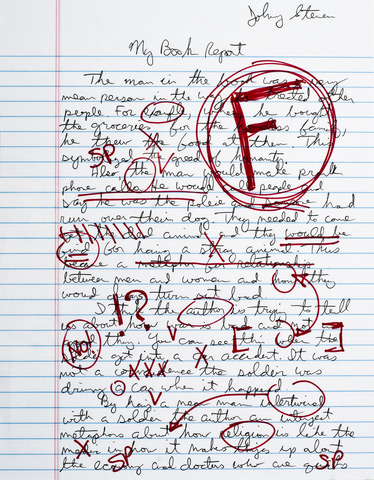I was traumatized in first grade because I scored an S in spelling on my report card.
And though I’ve been able to let that go (and formed a deep relationship with spell check in the meantime) it brings to light an important issue. What did that grade really mean? The guide on the report card said S meant satisfactory, but what does a simple letter filled in a box mean to a student? Especially a child?
Children aren’t the only ones who struggle with the vagueness and anonymity that come with the letters A through F on a piece of paper, whether it be homework, a written assignment, or a test. Students who want to learn and improve their English benefit from more specific and in depth feedback than a simple letter written in red at the top of the page. And it’s our job as their teachers to be sure they get that feedback they are seeking, that information they need on where they are succeeding and areas in which they need to improve.
If you are looking for some other ways to give students feedback on how they’re really doing, here are some ideas for you.
Try These 3 Methods for Letting Your Students Know How They’re Really Doing
-
1
Notecard Grading

The wrong way to grade a paper
Have you ever gotten back a written assignment that looks like the teacher graded it while bleeding profusely from the pen? I remember in my education courses in college, my teacher recommended not using a red pen to grade. It has so much stigma, so much emotion tied to it when used for grading, just the color can paralyze some students. At her advice, I chose green for my go to grading hue. And while that alone will be an improvement for most students, you can take your written feedback a bit farther by not writing on their paper at all. Instead, try limiting your comments to what you can fit on a three by five notecard.
Try limiting your comments to what you can fit on a three by five notecard
When you limit the space you have and you put it someplace other than on your students’ papers, some of heat emotion tied to getting back an ink laden assignment dissipates, and your students will have fewer emotional barriers blocking them from hearing what you are trying to say. You can still make notes as you read if you choose, but rather than writing out several comments at the end of their assignment try this instead.
the Oreo methodTake a small notecard and write three pieces of feedback on it. This feedback should focus on two strengths in the assignment and one area of improvement. Sometimes this is called the Oreo method – sandwich your constructive criticism between two bits of encouragement. It’s a good method that softens the blow that some people feel with any hint of imperfection. Staple your card to the top of your student’s paper and hand it back that way. Or put your student’s name at the top of the paper and hand those back separately from the papers themselves.
Your students will get valuable feedback without having to wade through oceans of red ink that might otherwise set them in a panic.
-
2

Sticky Note Feedback
I love using sticky notes to give my students feedback. I find it is a great way to give in the moment comments after the moment has passed. Here’s how to do it.
While students are working independently during discussion time, walk around the room and listen in on what students are saying and how well they are speaking. Your observations should be both positive as well as constructive. For each observation, write it on a different sticky note and jot down the student’s name or initials. Make another observation, write another note. Be as specific in your notes as you can since your students won’t see them until later. Hold on to your sticky notes for the moment and go about your normal classroom business.
When class is over for the day, take a look at the notes you made transferring any necessary information to your grading records. Then take the sticky notes and place them on the appropriate student desks. They will stay there until the next morning when your students come into class and find the note on their performance from the previous day.
If you get in the habit of making notes this way, you don’t have to observe every student every day.
If you get in the habit of making notes this way, you don’t have to observe every student every day. Try to focus on three or four students each day, and depending on how big your class is, each person may be getting feedback several times a week. Also, you won’t have to rack your brain when it’s time to give progress reports. You’ll have regular observations you can use as a basis for your students’ speaking grades or class participation grades.
-
3
The Rubric Cube
In my experience, rubrics are one of the most effective means of grading non-quantifiable assignments such as written essays and speaking presentations. When you can’t take a percentage of correct answers to come up with your grade, it can be a challenge to be consistent when grading student performance. A rubric eliminates that problem. I won’t go into detail on how to create a rubric. I will tell you what to do with the rubric once you have created it. I call it the rubric cube because there are three ways to use a rubric for student feedback.
First, use the rubric to grade your student’s performance. As you read or listen, decide on which level of the rubric best described the language use. If you have several criteria you are grading on, note on the rubric itself where the student falls in each category. Then take the average level of all the categories combined. That is the grade you give your student. Put their name on the rubric and set it aside. Take a fresh copy for the next person.
Second, for written assignments, give your student back their composition and give them a blank copy of the rubric. Ask them to read their paper and assess themselves based on the categories and levels of performance in the rubric. Then have each student give themselves a grade.
Third, either working independently or in a conference with you, have your student compare the rubric they filled out and the one you filled out. Ask your student to note areas in which you scored them the same as well as areas in which your assessments differed. If you can, have a discussion with your student about the differences in your assessments and explain why you chose the performance levels you did.
You can also give your students a rubric for an assignment before they complete it. That way they will have in mind exactly what you are looking for when you determine their grades and shouldn’t be surprised when you give them the results of their performance.
Whether it’s an A or a C, letter grades can be less than informative at times, especially in areas that you can’t crunch numbers to come up with a grade.
Try one of these feedback methods and both you and your students will benefit from a more fully explained assessment on their assignments.
P.S. If you enjoyed this article, please help spread it by clicking one of those sharing buttons below. And if you are interested in more, you should follow our Facebook page where we share more about creative, non-boring ways to teach English.








